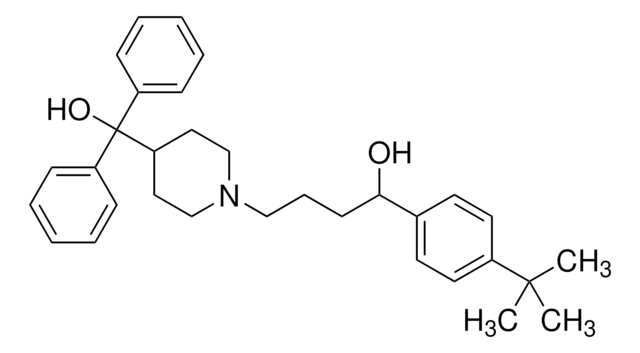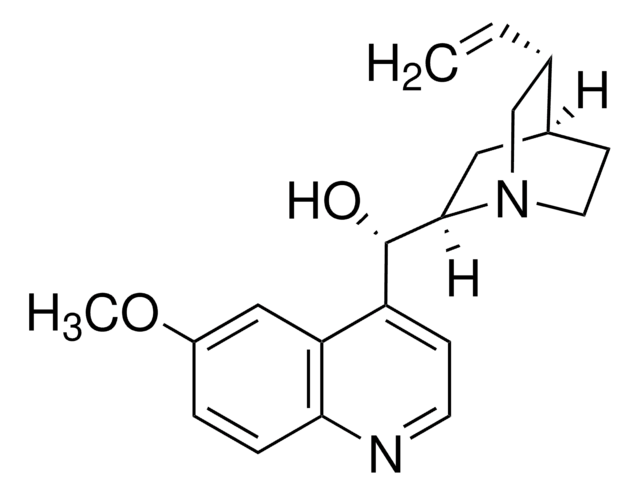Wszystkie zdjęcia(3)
Kluczowe dokumenty
A7205
3-Acetamidophenol
97%
Synonim(y):
3′-Hydroxyacetanilide
Zaloguj sięWyświetlanie cen organizacyjnych i kontraktowych
About This Item
Wzór liniowy:
CH3CONHC6H4OH
Numer CAS:
Masa cząsteczkowa:
151.16
Beilstein:
907998
Numer WE:
Numer MDL:
Kod UNSPSC:
12352100
Identyfikator substancji w PubChem:
NACRES:
NA.22
Formularz:
crystals
Próba:
97%
Polecane produkty
Poziom jakości
Próba
97%
Formularz
crystals
mp
145-148 °C (lit.)
ciąg SMILES
CC(=O)Nc1cccc(O)c1
InChI
1S/C8H9NO2/c1-6(10)9-7-3-2-4-8(11)5-7/h2-5,11H,1H3,(H,9,10)
Klucz InChI
QLNWXBAGRTUKKI-UHFFFAOYSA-N
Szukasz podobnych produktów? Odwiedź Przewodnik dotyczący porównywania produktów
Powiązane kategorie
Hasło ostrzegawcze
Warning
Zwroty wskazujące rodzaj zagrożenia
Zwroty wskazujące środki ostrożności
Klasyfikacja zagrożeń
Eye Irrit. 2 - Skin Irrit. 2
Kod klasy składowania
11 - Combustible Solids
Klasa zagrożenia wodnego (WGK)
WGK 2
Temperatura zapłonu (°F)
Not applicable
Temperatura zapłonu (°C)
Not applicable
Środki ochrony indywidualnej
dust mask type N95 (US), Eyeshields, Gloves
Wybierz jedną z najnowszych wersji:
Masz już ten produkt?
Dokumenty związane z niedawno zakupionymi produktami zostały zamieszczone w Bibliotece dokumentów.
Identification of hepatic protein targets of the reactive metabolites of the non-hepatotoxic regioisomer of acetaminophen, 3'-hydroxyacetanilide, in the mouse in vivo using two-dimensional gel electrophoresis and mass spectrometry.
Y Qiu et al.
Advances in experimental medicine and biology, 500, 663-673 (2002-01-05)
M A Bae et al.
Molecular pharmacology, 60(4), 847-856 (2001-09-20)
Acetaminophen (AAP), a widely used analgesic drug, can damage various organs when taken in large doses. In this study, we investigate whether AAP causes cell damage by altering the early signaling pathways associated with cell death and survival. AAP caused
M A Tirmenstein et al.
The Journal of biological chemistry, 264(17), 9814-9819 (1989-06-15)
Acetaminophen (250 mg/kg) administered intraperitoneally to fasted, phenobarbital-induced mice produced hepatotoxicity. No hepatotoxicity was observed after the administration of the regioisomer 3'-hydroxyacetanilide (600 mg/kg). Similar levels of covalent binding to liver homogenates occurred in mice receiving either acetaminophen or 3'-hydroxyacetanilide
N G Palmen et al.
Toxicology, 84(1-3), 157-170 (1993-11-12)
A model system for the detection of reactive metabolites, using glutathione depletion after microsomal activation, has been described previously. We developed a battery of complementary test systems using rat liver microsomes for metabolism and aqueous glutathione solutions, human erythrocytes or
T G Myers et al.
Chemical research in toxicology, 8(3), 403-413 (1995-04-01)
Acetaminophen (4'-hydroxyacetanilide), a widely used analgesic/antipyretic drug, is hepatotoxic in large doses, whereas the m-hydroxy isomer of acetaminophen, 3'-hydroxyacetanilide, is not hepatotoxic. Both are oxidized by mouse liver cytochromes P-450 to reactive metabolites that bind covalently to hepatic proteins. Because
Nasz zespół naukowców ma doświadczenie we wszystkich obszarach badań, w tym w naukach przyrodniczych, materiałoznawstwie, syntezie chemicznej, chromatografii, analityce i wielu innych dziedzinach.
Skontaktuj się z zespołem ds. pomocy technicznej







